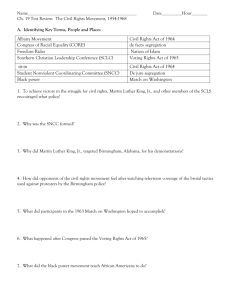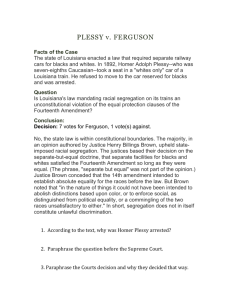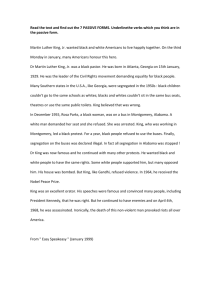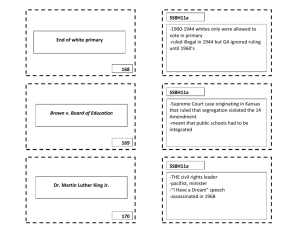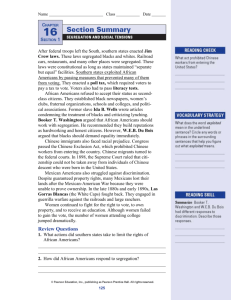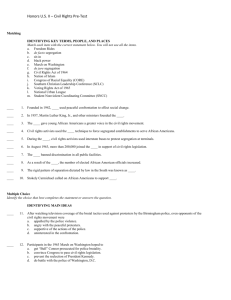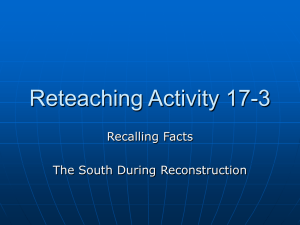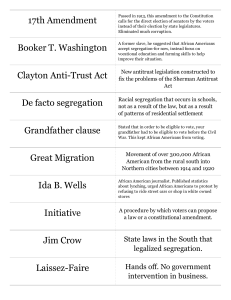Chapter 29: Civil Rights
advertisement
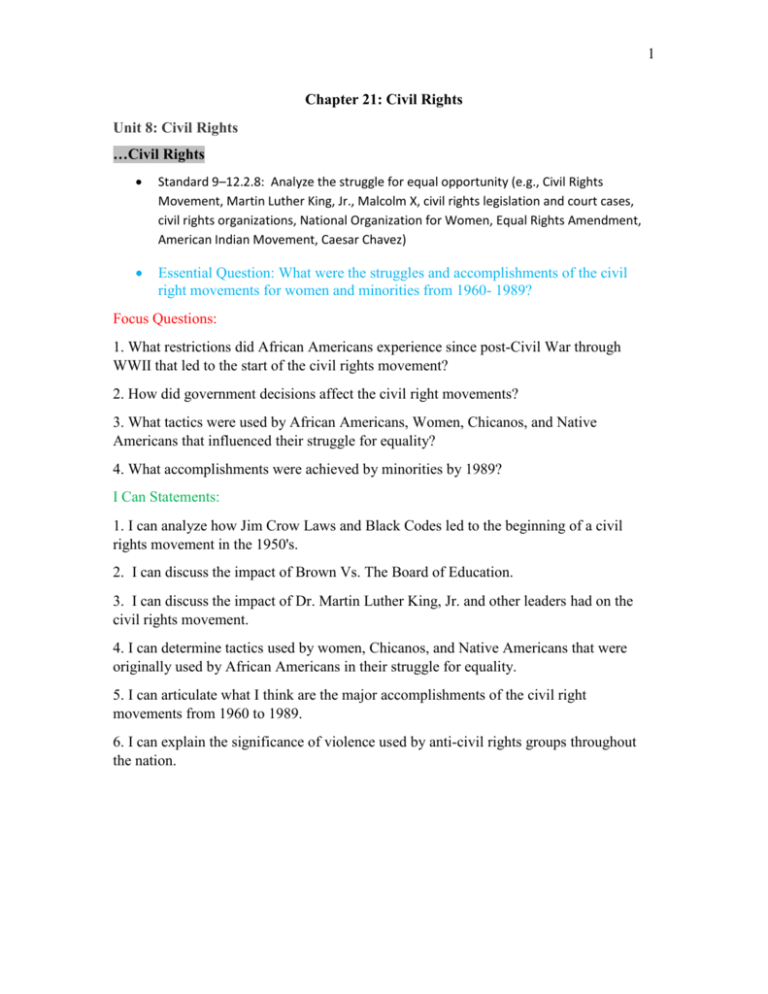
1 Chapter 21: Civil Rights Unit 8: Civil Rights …Civil Rights Standard 9–12.2.8: Analyze the struggle for equal opportunity (e.g., Civil Rights Movement, Martin Luther King, Jr., Malcolm X, civil rights legislation and court cases, civil rights organizations, National Organization for Women, Equal Rights Amendment, American Indian Movement, Caesar Chavez) Essential Question: What were the struggles and accomplishments of the civil right movements for women and minorities from 1960- 1989? Focus Questions: 1. What restrictions did African Americans experience since post-Civil War through WWII that led to the start of the civil rights movement? 2. How did government decisions affect the civil right movements? 3. What tactics were used by African Americans, Women, Chicanos, and Native Americans that influenced their struggle for equality? 4. What accomplishments were achieved by minorities by 1989? I Can Statements: 1. I can analyze how Jim Crow Laws and Black Codes led to the beginning of a civil rights movement in the 1950's. 2. I can discuss the impact of Brown Vs. The Board of Education. 3. I can discuss the impact of Dr. Martin Luther King, Jr. and other leaders had on the civil rights movement. 4. I can determine tactics used by women, Chicanos, and Native Americans that were originally used by African Americans in their struggle for equality. 5. I can articulate what I think are the major accomplishments of the civil right movements from 1960 to 1989. 6. I can explain the significance of violence used by anti-civil rights groups throughout the nation. 2 Chapter 21: Civil Rights Section 1: Taking on Segregation I. The Segregation System A. Barron vs. Mayor of Baltimore (1833)-The case was particularly important in terms of American government because it stated that the freedoms guaranteed by the Bill of Rights did not restrict the state governments. 1. Facts of the Case a. John Barron was co-owner of a profitable wharf in the harbor of Baltimore. As the city developed and expanded, large amounts of sand accumulated in the harbor, depriving Barron of the deep waters which had been the key to his successful business. He sued the city to recover a portion of his financial losses. 2. Question a. Does the Fifth Amendment deny the states as well as the national government the right to take private property for public use without justly compensating the property's owner? 3. Conclusion a. No. The Court announced its decision in this case without even hearing the arguments of the City of Baltimore. Writing for the unanimous Court, Chief Justice Marshall found that the limitations on government articulated in the Fifth Amendment were specifically intended to limit the powers of the national government. Citing the intent of the framers and the development of the Bill of Rights as an exclusive check on the government in Washington D.C., Marshall argued that the Supreme Court had no jurisdiction in this case since the Fifth Amendment was not applicable to the states. B. Civil Rights Act of 1875 (1883): the act outlawed segregation in public facilities (act challenged in 1883 and found unconstitutional by an allwhite Supreme Court-see case below) 1. Facts of the Case a. The Civil Rights Act of 1875 affirmed the equality of all persons in the enjoyment of transportation facilities, in hotels and inns, and in theaters and places of public amusement. Though privately owned, these businesses were like public utilities, exercising public functions for the benefit of the public and, thus, subject to public regulation. In five separate cases, a black person was denied the same accommodations as a white person in violation of the 1875 Act. 3 2. Question a. Does the Civil Rights Act of 1875 violate the 10th Amendment of the Constitution which reserves all powers not granted to the national government to the states or to the people? 3. Conclusion a. The Fourteenth Amendment restrains only state (state is the old term used for nation) action. And the fifth section of the Amendment empowers Congress only to enforce the prohibition on state action. The amendment did not authorize national legislation on subjects which are within the domain of the state. Private acts of racial discrimination were simply private wrongs that the national government was powerless to correct. C. The incorporation of the Bill of Rights (or incorporation for short) is the process by which American courts have applied portions of the U.S. Bill of Rights to the states. 1. Prior to the 1890s, the Bill of Rights was held only to apply to the federal government. 2. Under the incorporation doctrine, most provisions of the Bill of Rights now also apply to the state and local governments, by virtue of the due process clause of the Fourteenth Amendment of the Constitution. 3. Chicago, Burlington & Quincy Railroad Co. v. City of Chicago, (1897) started incorporation: a. Incorporated the takings clause of the 5th amendment into the due process clause of the 14th amendment by requiring states to provide just compensation for seizing private property. D. Plessy v. Ferguson (1896) 1. Facts of the Case a. The state of Louisiana enacted a law that required separate railway cars for blacks and whites. In 1892, Homer Adolph Plessy--who was seven-eighths Caucasian--took a seat in a "whites only" car of a Louisiana train. He refused to move to the car reserved for blacks and was arrested. 2. Question a. Is Louisiana's law mandating racial segregation on its trains an unconstitutional infringement on both the privileges and immunities and the equal protection clauses of the Fourteenth Amendment? 3. Conclusion (because of the ruling in this case, Jim Crow laws were passed throughout the South) a. No, the state law is within constitutional boundaries. The majority, in an opinion authored by Justice Henry Billings Brown, upheld state-imposed racial segregation. The justices based their decision on the separate-but-equal doctrine, that 4 II. separate facilities for blacks and whites satisfied the Fourteenth Amendment so long as they were equal. (The phrase, "separate but equal" was not part of the opinion.) Justice Brown conceded that the 14th amendment intended to establish absolute equality for the races before the law. But Brown noted that "in the nature of things it could not have been intended to abolish distinctions based upon color, or to enforce social, as distinguished from political equality, or a commingling of the two races unsatisfactory to either." In short, segregation does not in itself constitute unlawful discrimination. E. After the Civil War, some African Americans tried to escape Southern racism by moving north 1. Many left the South in order to find jobs in the North during WW I 2. African Americans quickly discovered that discrimination also existed in the North a. Many African Americans had to live in all black neighborhoods and were resented b/c they competed with whites for jobs F. The events of WW II set the stage for the civil rights movement 1. Demand for soldiers created a shortage in white male workers a. The labor shortage created job opportunities for blacks 2. Nearly one million African Americans served in the armed forces, which needed so many fighting men the military had to end its discriminatory policies a. African Americans returned home determined to fight for their own freedom 3. During WW II, civil rights organizations campaigned for African-American voting rights and challenged Jim Crow laws a. FDR responded by issuing executive orders prohibiting racial discrimination by federal agencies and all companies that were engaged in war work G. Voting Rights in America by race and sex (individual states still tried to control who voted): 1. 15th Amendment (1870) = African American men can vote 2. 19th Amendment (1920) = Women can vote 3. Indian Citizen Act (1924) = Native Americans can have dual citizenship (tribal and U.S citizenship)-voting problematic 4. Voting Rights Act (1965) = Outlawed discriminatory voting practices (All citizens can vote including all Native Americans) Challenging Segregation in Court A. The NAACP legal strategy focused on the inequality b/w the separate schools that many states provided (Plessy v. Ferguson-separate but equal is OK) 1. Harvard University law professor and chief legal counsel for the NAACP, Charles Hamilton Houston, realized the nation 5 III. spent ten times as much money educating a white child as an African-American child a. In 1938, he placed a team of his best law students under the direction of Thurgood Marshall b. Thurgood and his team of lawyers won 29 out of 32 cases argued before the Supreme Court 2. Many cases chipped away at segregation a. Morgan v. Virginia (1946): Supreme Court declared unconstitutional those state laws mandating segregated seating on interstate buses b. Sweatt v. Painter (1950): Supreme Court ruled state law schools must admit black applicants, even if separate black schools existed B. Brown v. Board of Education (1954-Civil Rights) -The father of eight-year-old Linda Brown had charged the board of education of Topeka, Kansas, with violating Linda’s rights by denying her admission to an all-white elementary school four blocks from her house (the nearest all-black elementary school was 21 blocks away) 1. Facts of the Case: a. Black children were denied admission to public schools attended by white children under laws requiring or permitting segregation according to the races. The white and black schools approached equality in terms of buildings, curricula, qualifications, and teacher salaries. This case was decided together with Briggs v. Elliott and Davis v. County School Board of Prince Edward County. 2. Question: a. Does the segregation of children in public schools solely on the basis of race deprive the minority children of the equal protection of the laws guaranteed by the 14th Amendment? 3. Conclusion: a. Yes. Despite the equalization of the schools by “objective” factors, intangible issues foster and maintain inequality. Racial segregation in public education has a detrimental effect on minority children because it is interpreted as a sign of inferiority. The long-held doctrine that separate facilities were permissible provided they were equal was rejected. Separate but equal is inherently unequal in the context of public education. The unanimous opinion sounded the death-knell for all forms of state-maintained racial separation. Reaction to the Brown Decision A. Within a year, more than 500 school districts had desegregated their classrooms 1. In some states the KKK reappeared and White Citizens Councils boycotted businesses that supported desegregation 6 2. In 1955 the Supreme Court handed down a second ruling, known as Brown II, which ordered school desegregation implemented, “with all deliberate speed.” a. President Eisenhower, initially, refused to enforce compliance B. Brown v. Board of Education II (1955) 1. Facts of the Case: a. After its decision in Brown I which declared racial discrimination in public education unconstitutional, the Court convened to issue the directives which would help to implement its newly announced Constitutional principle. Given the embedded nature of racial discrimination in public schools and the diverse circumstances under which it had been practiced, the Court requested further argument on the issue of relief. 2. Question: a. What means should be used to implement the principles announced in Brown I? 3. Conclusion: a. The Court held that the problems identified in Brown I required varied local solutions. Chief Justice Warren conferred much responsibility on local school authorities and the courts which originally heard school segregation cases. They were to implement the principles which the Supreme Court embraced in its first Brown decision. Warren urged localities to act on the new principles promptly and to move toward full compliance with them "with all deliberate speed." C. In 1948, Arkansas became the first Southern state to admit African Americans to state universities without being required by a court order Little Rock, Arkansas 1. The Little Rock, Arkansas school board was first in the South to announce compliance with Brown decision a. Little Rock citizens elected two men to the school board who publicly backed desegregation-and the school superintendent, Virgil Blossom, planned for desegregation 2. In 1957, Governor Orval Faubus ordered Arkansas, National Guard to surround the all-white Central High School in an effort to prevent the “Little Rock Nine” (nine black students) from integrating the school (Faubus claimed he was worried about armed protesters) a. He was running for reelection and wanted to ensure his victory by retaining the faithful segregationists (governor from 1955-1967-plan worked) b. A federal judge ordered Faubus to let the students into the school 7 IV. V. 3. The National Guard prevented the “Little Rock Nine” from entering Central High for three weeks a. A court order forced the governor to remove the National Guard and allow the nine blacks to enter b. When the nine attempted to enter the school, a white mob started rioting 4. President Eisenhower federalized 1,000 National Guard troops to protect the nine black students that finally entered the school a. At the end of the year, Faubus chose to shut down the school rather than allow integration to continue b. Gallop poll from 1958 revealed Faubus was one of the top ten most admired men in America 5. Civil Rights Act of 1957: made it a federal crime to prevent qualified voters from voting (Civil Rights Commission enforced the law, but discrimination remained) a. The law also gave the attorney general greater power over school desegregation b. Senator Lyndon B. Johnson, of Texas, put the time in to push this bill through the Senate The Montgomery, Alabama Bus Boycott A. On Dec 1, 1955, Rosa Parks, a seamstress and an NAACP officer, refused to give up her front row seat in the colored section of a bus to a white man 1. Parks was arrested and convicted of violating the city’s segregation laws 2. Montgomery Improvement Association (MIA): group of local civil rights leaders that persuaded the community to boycott the city’s bussing system a. Martin Luther King, Jr. (26-years-old) was the spokesman for the MIA (Baptist minister) b. King was an ordained minister and earned a Ph.D. in theology from Boston University 3. The Montgomery, Alabama busing system was about to go broke after the year plus strike, so they desegregated a. In 1956, the Supreme Court declared Alabama’s segregation laws unconstitutional 4. White radicals bombed King’s home and other MIA leaders’ houses, and some were fired from their job a. King urged people to not respond with more violence b. King was accused of being a Communist Martin Luther King and the SCLC A. MIA transformed into Southern Christian Leadership Conference (SCLC-1957): alliance of church-based African-American organizations dedicated to ending discrimination 8 VI. 1. The first director of the SCLC, Ella Baker, helped students at Shaw University (all-black university) organize a national protest group a. Student Nonviolent Coordinating Committee (SNCC): loose association of student activists throughout the South b. Members of the SNCC didn’t always follow Martin Luther King Jr. idea of meeting violence with nonviolence The Movement Spreads A. Congress of Racial Equality (CORE): a northern based civil rights group 1. Stages the first sit-ins: African-American protesters sat down at segregated lunch counters in Chicago and refused to leave until they were served 2. In 1960, African-American students from North Carolina’s Agricultural and Technical College staged a sit-in at a white-only lunch counter at a Woolworth’s store in Greensboro, North Carolina a. Television crews broadcast the non-violent sit-ins, and the violent responses into the homes of Americans everyday b. Americans could no longer deny the fact that racism existed Section 2: The Triumphs of a Crusade I. Riding for Freedom A. Freedom Rides (1961): white and black civil rights activists that left D.C. for and rode interstate buses into the segregated southern United States in 1961 and following years to challenge the non-enforcement of the United States Supreme Court decisions Irene Morgan v. Commonwealth of Virginia (1946) and Boynton v. Virginia (1960), which ruled that segregated public buses were unconstitutional (Southern states had ignored the rulings and the federal government did nothing to enforce them) 1. CORE members made it as far as Anniston, Alabama before their bus was fire-bombed by white mob a. White racists jumped on the bus earlier with chains, brass knuckles, and pistols threatening and beating the CORE members b. The bus company refused to carry the CORE members any farther 2. When CORE was forced to call off the ride, members of the SNCC continued the ride a. When the SNCC reached Birmingham, Alabama, policemen pulled them from the bus, beat them, and drove them into Tennessee 9 II. 3. The members of the SNCC returned to a Birmingham bus terminal and sat in the whites-only waiting room until the issue was resolved a. The bus driver would not transport them out of fear for his life b. U.S. Attorney General Robert Kennedy convinced the bus driver to proceed B. Alabama officials promised Kennedy that the riders would be protected, but that didn’t happen 1. A white mob greeted the riders with bats and lead pipes when they arrived in Montgomery, Alabama a. There were no cops in sight to protect the riders 2. The violence provoked exactly what the freedom riders wanted a. President Kennedy arranged for the Justice Department to send 400 U.S. marshals to protect the riders as they traveled to Jackson, Mississippi b. The attorney general and the Interstate Commerce Commission banned segregation in all interstate travel facilities, including waiting rooms, restrooms, and lunch counters Standing Firm A. In Sept, 1962, the NAACP obtained a court order requiring the University of Mississippi to admit African American Air Force veteran applicant James Meredith 1. Governor Ross Barnett refused to let Meredith register as a student a. President Kennedy ordered federal marshals to escort Meredith to the registrar’s office 2. On the night of Sept 30, riots broke out on campus, resulting in two deaths a. Thousands of soldiers were needed to stop the riots b. Federal officials accompanied Meredith to class the entire year and protected his parents from nightriders who shot up their house B. Birmingham, Alabama was known for its strict enforcement of segregation in public life 1. Reverend Fred Shuttlesworth, head of the Alabama Christian Movement for Human Rights and secretary of the SCLC, decided something needed to done in 1963 a. Martin Luther King, Jr. and the SCLC were invited to help promote desegregation in Birmingham by using non-violent sit-ins b. On Good Friday, April 12, 1963, King and others were arrested, but posted bail on April 20 and continued demonstrating 10 III. 2. Over a thousand African-American children marched in Birmingham on May 2 and another group marched on May 3 (“children’s crusade”) a. Police chief Bull Connor ordered the police to attack the marchers with high-pressure hoses, dogs, and night-sticks b. TV cameras caught ever moment and millions of viewers witnessed the brutality (Birmingham officials felt pressured to end segregation) C. In Albany, Georgia nonviolent protests were staged 1. Police Chief Laurie Pritchett met nonviolence with nonviolence a. Using nonviolence, he arrested the protestors until no one was left to protest D. On June 11, 1963, the president sent troops to force Governor George Wallace to honor a court order desegregating the University of Alabama 1. Governor ran for the presidency four times (1964,68,72, and 1976) a. Won the governorship four times in Alabama (1962, 70, 74, and 1982) 2. JFK demanded that Congress pass a civil rights bill 3. Shortly after JFK’s speech, a sniper murdered Medgar Evers, NAACP field secretary and WW II veteran on June 12, 1963 in Jackson Mississippi a. Police arrested, but quickly released white supremacist, Byron de la Beckwith b. Based on new evidence discovered in 1990, Beckwith was placed on trial for the third time and finally found guilty of murder on Feb 5, 1994 (life in prison-died in 2001) Marching on Washington A. In support of JFK’s civil rights bill that he sent to Congress, labor leader A. Philip Randolph and Bayard Rustin of the SCLC summoned Americans to a march on Washington, D.C. 1. On August 28, 1963, over 250,000 people, including 75,000 whites, stood on the lawn of the Washington Monument and observed Martin Luther King, Jr. deliver the famous, “I Have a Dream” speech (start video at 10:30) a. Speech given in support of the Civil Rights Act JFK wanted to pass (LBJ pushed in through Congress in 1964) B. Two weeks after the speech, four young Birmingham girls were killed when a rider through a bomb into the church 1. In 2002, former Klansman Bobby Frank Cherry was convicted of first-degree murder in the 1963 fire bombing of the Birmingham church 11 IV. 2. After JFK was killed, President Johnson pledged to carry on JFK’s work a. Civil Rights Act of 1964: prohibited discrimination b/c of race, religion, national origin, and gender, and gave all citizens the right to enter libraries, parks, washrooms, restaurants, theaters, and other public accommodations Fighting for Voting Rights A. Freedom Summer: launched in 1964 as a campaign by CORE and the SNCC to register African American voters in Mississippi 1. Mississippi population was 45% black, but only 5% of African Americans could vote 2. Thousands of student volunteers, most of them white, were trained in nonviolent resistance and sent to Mississippi a. Two white New Yorkers (Michael Schwerner and James Chayney) and a black Mississippian (Andrew Goodman), all civil rights workers, were killed by the KKK b. Many believe the FBI only got involved in the killings once it was discovered that two white men were killed 3. The state never charged anyone with murder, and federal statutes against murder didn’t exist at the time a. The federal gov’t tried 18 men, including a part-time Baptist preacher named Edgar Ray Killen, on charges of conspiring to violate the civil rights of the victims b. On a 11-1 decision by the jury, he walked free (the lone holdout said she could never convict a preacher) 4. In 2005 Edgar Ray Killen, was found guilty on three counts of manslaughter a. The 1988 movie, Mississippi Burning, is based on this true story 5. Local blacks stopped registering to vote out of fear of being murdered a. Civil Rights leaders called for a march from Selma, Alabama to Montgomery, Alabama B. In an effort to gain a seat in Mississippi’s all-white Democratic Party, the SNCC organized the Mississippi Freedom Democratic Party (MFDP) 1. Fannie Lou Hamer represented the party at the 1964 Democratic National Convention a. In a televised speech, she described how she was jailed for registering to vote in 1962, and how police forced other prisoners to beat her 2. President Johnson feared he would loose the Southern white vote if the Democrats sided with the MFDP a. Johnson’s administration made a deal that the Democrats would give 2 of Mississippi’s 68 seats to the 12 MFDP, and promised to ban discrimination at the 1968 convention C. In 1965, the SCLC conducted a major voting rights campaign in Selma, Alabama (the SNCC had already been working there for two years) 1. Thousands were arrested and a demonstrator named Jimmy Lee Jackson was shot and killed a. Martin Luther King, Jr. responded by announcing a march from Selma, Alabama to Montgomery, Alabama, the state capital 2. The nation watched as the marchers were attacked and beaten just outside of Selma by police a. Thousands of Americans poured into Selma to show support 3. President Johnson pushed the passage of a Voting Rights Act because of Bloody Sunday D. Voting Rights Act of 1965: the act eliminated the so-called literacy tests that had disqualified many voters and stated that federal examiners could enroll voters who had been denied suffrage by local officials 1. The number of African American voters rose from 10% in 1964 to 60% in 1968 Section 3: Challenges and Changes in the Movement I. African Americans Seek Greater Equality 1. The problem facing African Americans in the North was de facto segregation: segregation that exists by practice and custom in the North 1. Eliminating de facto segregation involves changing peoples’ attitudes rather than repealing laws a. De jure segregation: segregation by law, which was the case in the South b. It much more difficult to convince whites to share economic power and social power (North) with African Americans than to convince them to share lunch counters and bus seats (South) 2. As African Americans moved north to find jobs during WW II, many whites moved to suburbs (“white flight”) a. Most African Americans lived in sub-par housing, and attended ill-equipped schools (unemployment was twotimes higher for blacks compared to whites) 3. Police forces were often brutal in African American communities a. Whites threw rocks and bottles and stoned King and his followers as they marched down the Chicago streets in protest of police brutality 13 II. 2. On August 11, 1965, one of the worst riots in U.S. history raged on the streets of Watts, a predominantly African-American neighborhood in Los Angeles 1. The Watts Riots broke out in Los Angeles during a routine arrest a. The riots lasted 6 days, 34 were killed, and 4,000 were arrested b. Kerner Commission: federal report charged that white racism was largely responsible for the tensions that led to the riots 2. African Americans burned down homes and businesses out of frustration a. The question that many whites had is, “Why would African Americans burn down their own neighborhoods?” b. African Americans felt where they lived, how they lived, and what they had to tolerate was all created by white society 3. Before the riots started, Johnson announced his “War on Poverty” a. Martin Luther King, Jr. commented that, The Great Society has been shot down on the battlefields of Vietnam.” New Leaders Voice Discontent A. Malcolm Little was sent to prison at the age of 20 for burglary 1. While in prison Malcolm X embraced the teachings of Elijah Muhammad’s Nation of Islam or Black Muslims a. The X symbolizes his lost African surname 2. Upon his release from prison in 1952, he became an Islamic minister a. He preached that whites were the cause of the black conditions and that blacks should separate from white society (advocated armed self-defense) 3. Malcolm X received a great deal of publicity, which caused the following: a. His call for armed self-defense frightened most whites and many moderate African Americans b. Reports of the attention Malcolm X received awakened resentment in some other members of the Nation of Islam B. In March 1964, Malcolm broke with Elijah Muhammad over differences in strategy and doctrine and formed another Muslim organization 1. Malcolm converted to orthodox Islam after a pilgrimage to Mecca in Saudi Arabia a. Malcolm witnessed all races worshipping together and realized harmony could exist 14 III. b. After his trip to Mecca, Malcolm’s attitude towards whites changed radically 2. B/c of his split with the Black Muslims, Malcolm worried his life was in danger (Feb 21, 1965 Malcolm X was /assassinated/shot 16 times by three men) C. In 1966, James Meredith, the man who integrated the University of Mississippi, set out on what he called a “walk against fear.” 1. Meredith was shot by a white racist and was too injured to continue a. Martin Luther King, Jr., of the SCLC, Floyd McKissick of CORE, and Stokely Carmichael of SNCC decided to finish what Meredith started 2. The members of CORE and the SNCC became somewhat militant and began shouting phrases that promoted violence (Martin Luther King, Jr. tried to control the groups) a. Carmichael was arrested in Greenwood, Mississippi for setting up a tent on the grounds of an all-black high school 3. Carmichael appeared at a rally beaten and bruised, which caused an uproar within the crowd a. Black Power: used by Stokely Carmichael in the 1960s that encouraged African-American pride and political and social leadership b. King urged Carmichael to stop using the phrase b/c he believed it would provoke violence D. In 1966, Huey P. Newton (murdered in 1989) and Bobby Seale (still alive) founded the political party in Oakland, California known as the Black Panthers: promote self determination in black communities and fight police brutality in the ghetto 1. Advocated self-sufficiency for African-American communities, as well as full employment and decent housing 2. Also believed blacks should be exempt from military service b/c an unfair number of black youths had been drafted to serve in Vietnam a. The Panthers dressed in black, preached self-defense, and sold copies of the writings of Mao Zedong, the leader of the Chinese Communist revolution b. The Panthers were investigated by the FBI, but gained popularity in many of the ghettos 1968-A Turning Point in Civil Rights A. Martin Luther King, Jr. called a Poor People’s March on Washington to protest the misuse of gov’t funds 1. King went to Memphis, Tennessee to show support for garbage workers strike on April 3, 1968 a. On April 4, 1968 King was killed by a sniper named James Earl Ray, while standing on the hotel balcony b. Ray escaped from prison in 1967 15 IV. B. Robert F. Kennedy was campaigning for the 1968 Democratic presidential nomination on the night of King’s death 1. Kennedy was asked to cancel his appearance in an African American neighborhood, but chose to appear and ask the community to stay calm a. Over 100 cities were engulfed in flames b. Rioting occurred leaving 46 dead 2. In June 1968, Robert F. Kennedy was assassinated by a Jordanian immigrant, named Sirhan Sirhan, who was angry over Kennedy’s support of Israel Legacy of the Civil Rights Movement A. Kerner Commission (1968): committee President Johnson had appointed to study the causes of urban violence, issued a 200,000-word report 1. The panel listed one main cause of the violence; white racism a. Johnson ignored most of the panels’ recommendation in an effort to avoid agitating white Americans B. The civil rights movement ended de jure segregation by bringing about legal protection for the civil rights of all Americans 1. Civil Rights Act of 1968: ended discrimination in housing 2. Once school desegregation ended, many more African Americans finished high school and the numbers attending college increased 3. The civil rights movement also gave African Americans a sense of pride a. The black community proudly displayed their heritage b. College students demanded Black Studies programs c. More blacks were on TV and in film 4. African Americans also made major political gains a. By 1970 2/3rds of African Americans were registered to vote b. African Americans holding office grew from fewer than 100 in 1965 to more than 7,000 in 1992 C. African Americans still faced many challenges in the 1970s, such as poverty, discrimination, racism, etc 1. Some felt more tax dollars should be spent on the inner city area(s) and forced busing would aid in desegregation a. Public support for the civil rights movement eroded b/c of urban riots and fear of the Black Panthers 2. In 1996-1997, 28% of blacks in the South and 50% of blacks in the Northeast were attending schools with fewer than 10% whites a. Blacks have a poverty rate than his three times that of whites 3. Affirmative Action (1960s): involve making special efforts to hire or enroll groups that have suffered discrimination a. By the late 1970s, some people began to criticize affirmative action programs as “reverse discrimination.” D. Regents of the University of California v. Bakke 16 1. Facts of the Case a. Allan Bakke, a thirty-five-year-old white man, had twice applied for admission to the University of California Medical School at Davis. He was rejected both times. The school reserved sixteen places in each entering class of one hundred for "qualified" minorities, as part of the university's affirmative action program, in an effort to redress longstanding, unfair minority exclusions from the medical profession. Bakke's qualifications (college GPA and test scores) exceeded those of any of the minority students admitted in the two years Bakke's applications were rejected. Bakke contended, first in the California courts, then in the Supreme Court, that he was excluded from admission solely on the basis of race. 2. Question a. Did the University of California violate the Fourteenth Amendment's equal protection clause, and the Civil Rights Act of 1964, by practicing an affirmative action policy that resulted in the repeated rejection of Bakke's application for admission to its medical school? 3. Conclusion a. No and yes. There was no single majority opinion. Four of the justices contended that any racial quota system supported by government violated the Civil Rights Act of 1964. Justice Lewis F. Powell, Jr., agreed, casting the deciding vote ordering the medical school to admit Bakke. However, in his opinion, Powell argued that the rigid use of racial quotas as employed at the school violated the equal protection clause of the Fourteenth Amendment. The remaining four justices held that the use of race as a criterion in admissions decisions in higher education was constitutionally permissible. Powell joined that opinion as well, contending that the use of race was permissible as one of several admission criteria. So, the Court managed to minimize white opposition to the goal of equality (by finding for Bakke) while extending gains for racial minorities through affirmative action. Section 4: Culture and Counterculture I. Counterculture: a movement made up mostly of white, middle-class college youth who had grown disillusioned with the war in Vietnam and injustices in American during the 1960s (society based on peace and love) A. Generation gap: was created between baby boomers and their elders 1. Questioned American values and blamed parents for problems in country B. Shaking the ivory tower 1. 70% of students went on strike at the University of California at Berkley a. Felt traditional courses were worthless (“Shut this factory down.”) 17 II. III. 2. Hippies rejected the Establishment (mainstream America) and wanted to a counterculture a. Native Americans did not appreciate hippies dress b. Do whatever comes to mind and try to shock older Americans 3. Hippies shared some of the beliefs of the New Left a. They felt American society-and its materialism, technology, and warhad grown hollow b. Influenced by the beats, many embraced Harvard psychology professor and counterculture philosopher Timothy Leary: “Tune in, turn on, drop out.” C. Elements of the counterculture 1. Timothy Leary a Harvard professor was fired for using LSD with his students a. He wanted people to drop-out of society b. STDs and drug addiction increased 2. Haight-Ashbury district: a hippie neighborhood in San Francisco a. Joined rural communes to live in harmony with nature b. Hundreds of those joining the communes were misfits, drug peddlers, and violent D. The hippie era was marked by rock ‘n’ roll music, outrageous clothing (tie-dyed T-shirts), sexual lenience, and illegal drugs (marijuana, LSD/acid) 1. Leary, an early experimenter with LSD, promoted the use of LSD as a “mind expanding” aid for self-awareness 2. Some turned to Zen Buddhism, which professed one could attain enlightenment through meditation rather than reading scripture Questioning American Society A. 1950s 80%of Americans said religion could answer all problems and in 1969 70% said religion was losing influence 1. Nuclear age made traditional religious answers irrelevant 2. Religious courses in college grew in popularity B. Pop artists: artists began selecting images that reflected everyday life (more relevant) 1. Pop art was characterized by bright, simple, commercial-looking images often depicting everyday life a. Andy Warhol wanted to prove that everything can be mass produced (mocked mass consumerism and America’s glorification of it) b. Warhol’s became famous for his bright silk-screen portraits of soup cans, Marilyn Monroe, and other icons of mass culture (mass produced and made to look impersonal) A Revived Women’s Movement A. Sparks of unrest 1. Betty Friedan’s The Feminine Mystique: rejected the popular idea that women were content with the roles of wife, mother, and homemaker a. Published The Fountain of Age: growing old does not mean growing worthless 18 IV. V. 2. National Organization for Women (NOW): lobbied for women’s rights a. 1968 disrupted Miss America pageant saying it degraded women B. A new generation 1. Gloria Steinem was a feminist, who wrote After Black Power, Women’s Liberation a. First openly feminist article 2. Helped develop the National Women’s Political Caucus a. Encouraged women to run for political office Musical Revolution A. The rebellious musical revolution in the 50s carried over into the 60s 1. British Invasion: arrival of English bands such as Beatles and Rolling Stones 2. Motown music: developed from blended traditional black music 3. Amplified instruments were used a. Jimi Hendrix was the leading electric guitar player that died in 1970 from a drug overdose b. Singer Janis Joplin also died from a drug overdose in 1970 4. Bob Dylan performed songs criticizing the Vietnam War B. Woodstock Music Festival 1. Held in upstate New York on a farm for three days (400,000 people) in August 1969 a. Jimi Hendrix, Janis Joplin, the Grateful Dead, etc played 2. Marked the high and low points of the counterculture a. A young African American fan was beat to death in full view of fans b. Occurred at a free concert held at Altamont Raceway near San Francisco C. Sexual Revolution of the 1960s: America’s attitude toward sexual behavior became more casual and permissive 1. The pill was introduced in 1960, which led to this increase in sexual freedom 2. TV, books, magazines, music, and movies began to address issues that were once prohibited, particularly sexual behaviors and violence The Conservative Response A. Conservative voices, such as Richard Nixon’s, expressed the anger people had regarding the countless changes occurring in American culture 1. FBI Director J. Edgar Hoover issued a warning that “revolutionary terrorism” was a threat on campuses and in cities 2. Some conservatives felt the counterculture had abandoned rational thought in favor of the senses and uninhibited self-expression 3. The conservative movement propelled Richard Nixon into the White House in 1968
